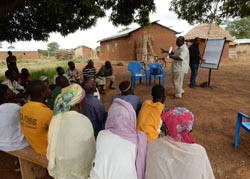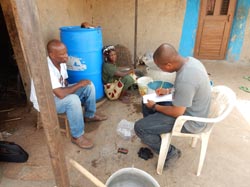Agriculture in Ghana is dominated by small-scale crop-livestock farming based on cereal and legume production and livestock rearing. Livestock rearing is an important component of crop-livestock farming system because it serves as an insurance against crop failure, a source of manure, a source of cash and makes good use of crop residues. The main objective of this study is to understand the roles and functions of grain legume residues in livestock farming systems and identify options to improve utilisation by smallholders in northern Ghana.
A rapid diagnostic survey has been conducted in eight communities to assess the existing and potential feed resources, their uses and seasonal gaps with respect to ruminant production in northern Ghana. The survey was carried out in May 2015, using the Feed Assessment Tool (FEAST) developed by International Livestock Research Institute (ILRI). FEAST is an analytical tool for identification of site-specific livestock feed resources and other related production constraints. This tool comprises Participatory Rural Appraisal (PRA) and structured questionnaire for individual interviews. The survey indicated that the major problems faced by livestock keepers in northern Ghana are poor housing, disease incidence with high mortality rates, inadequate feed in the dry season, theft and high cost of veterinary drugs.
 |
Figure left: Focus group discussion with farmers at Tusani community, Northern region Figure right: Individual interview with a female farmer at Sandu Community, Northern region |
 |
Preliminary findings on the use of grain legume residues indicated that farmers in Upper East region store about 70 - 80% of their grain legume residues to feed livestock later in the year. This is followed by farmers in Northern region who store about 10 – 30% of grain legume residues for animal feed while farmers in Upper West region store none of their crop residues but allow animals to graze them on the field. Other feed resources used in the area include agro-industrial by-products like corn mill waste flour, brewers’ spent grain, maize bran, and rice bran, cassava and yam peels.
On-farm trials are currently being conducted to determine the influence of grain legume genotype, environment and management practices on fodder yield and quality of soyabean, groundnut and cowpea. Future activities under the project will include: i) Characterization of diversity of crop-livestock farming systems and the roles and functions of grain legume residues in livestock feeding; ii) Identification best storage methods of grain legume residues; iii) Assessment of farmers’ perceptions on the use of grain legume residues as livestock feed. This will lead onto farm and farming system level analyses to explore options for intensification of livestock production.
Daniel Brain Akakpo, Wageningen University, The Netherlands
